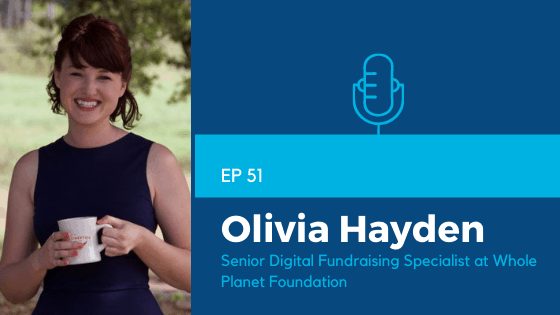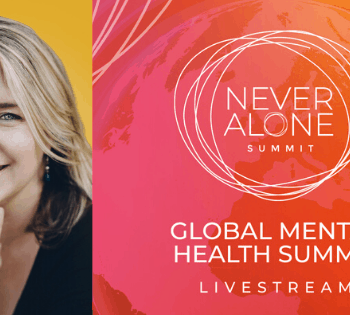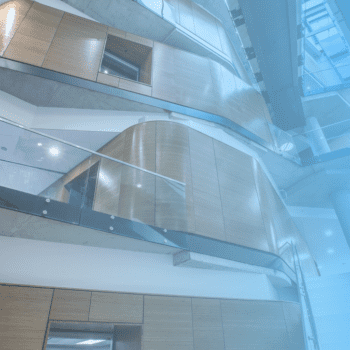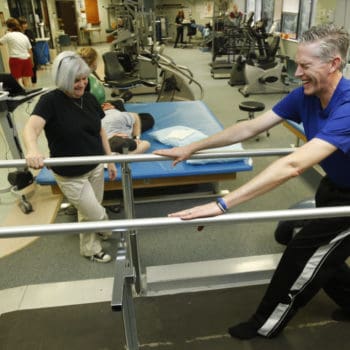In episode 51 of the Charity Charge Show, Stephen interviews Olivia Hayden, Senior Digital Fundraising Specialist for Whole Planet Foundation. Through her creative ideas, Olivia Hayden is responsible for the Whole Planet Foundations’ social media, website, and graphic design. The mission of the Whole Planet Foundation is to empower the world’s poorest people with microcredit in areas where Whole Foods market responsibly sources its products. Enjoy this blog, as Stephen and Olivia explore Olivia’s journey with the Whole Planet Foundation and the impact of their amazing nonprofit program.
Can you share a little bit about the Whole Planet Foundation and your role there?
Yes, of course. So Whole Planet Foundation was founded in 2005, by Whole Foods Market. I’m sure most of you are familiar with Whole Foods Market. John Mackey, our founder, and CEO back in 2003 attended an Ernst and Young Entrepreneurs conference. There were a lot of CEOs like himself in the audience. Muhammad Yunus, who is commonly known as the grandfather of microcredit, was the speaker at that event, and he got up in front of the crowd and he said, “I challenge all of you, CEOs, all of you, macro entrepreneurs, to empower micro-entrepreneurs.” And from there, the idea of the Whole Planet Foundation was born. What we do is we alleviate poverty through microcredit loans, to entrepreneurs living in poverty in the countries where Whole Foods, market source products. If a product is sourced by Whole Foods, we can work there to alleviate poverty. And that’s what we do. As for myself, I actually am the Senior Digital Fundraising Specialist for the foundation. I wear many, many hats, a lot of it is creative work, which is my favorite thing to do, and to be able to employ my creativity in the pursuit of helping women entrepreneurs is just fantastic every day.
Would you mind speaking to the audience a little bit about more tangible aspects of microcredit loans and how even a small dollar amount can lead to big impacts? Do you have a story in mind?
I’d love to. So we talked about microcredit but sometimes people have a hard time understanding how micro that is, especially for us in the United States. When we look at that average first loan, that Whole Planet Foundation funds, which is about $174. Right now, we might have a hard time understanding how a woman could use that money to lift herself and her family out of poverty. I do have a really personal story to share. I’ve been on the Whole Planet Foundation team for almost five years now. And about four years ago, I went on my first international impact visit with some of our donors to Paraguay, it was my first trip. I was also trying to translate Spanish, which at the end of the day became harder and harder for me. It was the last day of our trip.
My team leader Joy and I had separated into two different groups. I was with my group and we went to a community where I had never witnessed the kind of poverty that was present in this community. To be honest with you, it was a really eye-opening experience for me. So we had arrived in the community and we’ve been doing activities all day with our staff, from the microfinance partner from dusty on Paraguay. And as a result, we’re a little bit late to the community. As a time-bound American, I was feeling very anxious about Tibet. So at the end of the presentation by the clients, one of the women entrepreneurs grabbed me by the arm, and she said, “I want to show you my house.” I kind of looked at the donors and they were like, “Oh, but Olivia, we have to meet Joy for dinner real soon.” And I said, “You know what? We’re gonna go to her house.” Her name was Olga, we’re going to go to the oldest house and we’re going to go to anyone else’s house that wants us to enjoy will understand what she ultimately did. We ended up going for a walk through the community and really seeing the way that people were living in this community. It kind of varied from people living in wooden lien to some people who had plastic tarps as their roofs. It was a very impoverished community. We’re walking through and we have kind of a following now and everyone’s coming with us to this woman’s house and along the way, she’s telling us, “My house is kind of small, but I’m very proud of it” and she just wanted to show us how proud she was. So we show up at her house. She kind of has on one side, she’s got like a wooden shed with a dirt floor and on the other side, she’s got a house with a platform and real windows and a door that closes and a nice metal roof. We’re standing there outside, and she says, “Hang on, hang on.” And she runs back into the big house. And she comes out holding this giant heavy sewing machine under her arm. And she says with my first loan, which was $180, I bought this sewing machine. And then she points to how the little shack on this side the wooden structure with a dirt floor and she said, before I got my sewing machine, this was my home. Since I was able to sew my traditional Paraguayan lace onto tablecloths and bring them to the market, I’ve been able to use those profits to build this house, for my family to live in.
I think when people think about microcredit, if you think about the individual stories, it can sometimes be easier to understand the work that we do and the impact that it has.
I think that is one of the stories that I can use to best illustrate the power of that small loan, that loan that’s under $200. All she needed was access to a sewing machine. And it was nearly impossible for her to come up with that business capital. But she was ready, she had a plan, she had a skill and she was just waiting to put that to you.
When I first heard of microcredit, it just sounds too good to be true. I’m absolutely blown away by how it functions in the sense of the repayment rates. So just curious, what makes it work? What do you think happens there?
There are a few different factors. I think the first factor and maybe the most important factor is that most of the microfinance projects we are funding, 80% or more, are through this traditional Grameen Bank style lending. And if you’re not familiar with Grameen Bank, I mentioned Muhammad Yunus, but he founded the Grameen Bank in Bangladesh to lend to the poor and everyone thought he was crazy. So you’re not wrong to think that some people will be naysayers about this type of work and he actually started by learning at $26 out of his own pocket that was then repaid. He started out with this micro experiment that has since exploded, that Grameen style lending means that women are in solidarity groups. So what does that mean? That means that women would have to find some other people in their community, in order to be eligible for the loan. We say a lot that the microloans that we fund don’t require any collateral or any contract. So that group structure essentially, is the guarantee is the contract. And last year, I was lucky enough to go visit our partner in South Africa. And we were in the first group repayment meeting of the day.
So instead of the people going to the bank, the bank comes to the people, that’s another thing that makes this repayment so high, and then the group holds each other accountable. In our group, we had one group whose members, one of their members had gone to the city, not told anyone in the group just kind of left. And we watched as the entrepreneurs had to negotiate with the larger group, with the staff from our microfinance partner, and with each other to figure out the best way forward. What ended up happening was, they ended up each having to pony up the part of her loan because that’s part of the group guarantee with many of our partners. Then they worked with the microfinance institution to find a new group member to replace that entrepreneur who had left. When people are coming for a loan, it becomes important for you to know and trust the people in your loan group. Because you’re gonna have to work together if something happens to that person they’re unable to pay, so the group guarantee is a really big thing.
The other thing I would say is that we work in Procore, or it’s sometimes known as social microfinance. What is Procore mean? That means that our partners are really attuned to the local community, and they have people going in to do things like financial literacy training. So you mentioned, maybe they don’t have any financial expertise, maybe they don’t know how to run a business. Well, a lot of our partners provide training for them, so that they can learn more and just be better at what they do. But in many cases, the entrepreneurs know what they want to do, they have a skill, kind of like Olga, that you’re just waiting for that infusion of capital that I think a lot of us take for granted here.
Can you tell us just a little bit more about how people are interested in getting involved in both the full planning foundation and with that event? Where would they learn the kind of call to action you would have?
Of course, so our website is always available 24/7, whole planet foundation.org. Right now if you go to our website on the homepage, at the very top is a button that you can click to go straight to our auction. Also, if anyone out there is interested in sponsoring the event, we still have about a week left that we’re going to be taking sponsorships. And if anyone would like to donate an auction item, we are taking those until the final hour, the 19th of October. So like I said, you can preview those items. Now it’s free, you can choose to purchase a T-shirt, we’re doing a vintage reprint of an old favorite from a Whole Foods Market team member dessert. They’re gonna be soft. And it’s poverty in a museum design, which is kind of clever based on some words that Muhammad Yunus has said in the past and also based on our work trying to put poverty in a museum. So yeah, I click that link, check out the auction register for free, we will actually text you on the 19th in the morning to remind you that bidding is open. And then the bidding will close on October 25. And at one o’clock central time on October 25. You can also tune in we’re going to be posting our video program and then that will be available to view all day long. So if you want to be part of the conversation, you can use a hashtag party with a purpose. And just make sure you sign up so we can remind you when to bid. There are some really cool items, both from microcredit clients around the globe, and also from some of our local friends. Like I think there are two Yeti coolers now.
What are some of the steps you took out of college to get to where you are today and do you have any advice for your younger self?
Sure, I’d love to. I have a bit of an interesting path to where I got to today. Coming out of high school, I really didn’t know what I wanted to do. I did well in school, but I just didn’t feel ready to commit. So I took a year off. I thought, maybe I travel or maybe I do other things. And my parents basically said, “You’re 18, you’re going to start paying rent today, and good luck on having the money for anything else.” So I realized I need to get a full-time job. And that full-time job was at Whole Foods Market, bagging groceries and getting carts in the parking lot. I actually called the store about 12 times to get them to look at my resume, and they didn’t, they called me in the future. I think it was about three months in that they promoted me to cashier and that happened to be the first year of our Whole Planet Foundation campaign in stores. I was one of the first cashiers asking people for donations. I remember so keenly, at that time as an 18-year-old, working at a grocery store, thinking, “Wow, this is an amazing thing that my company does. This makes my job better every day.” It gives me a sense of purpose to be a part of this. Someday I’m going to work for the Whole Planet Foundation. I have to tell you, that most everyone in my store laughed me out of town because I was in Los Angeles, I hadn’t been to college, and I didn’t know anything about nonprofits. I just wanted to do this someday, and since then, I went to school I majored in communications and in fine art sculpture. After that, I said, “Okay, I’m an artist.”
I did those things because they were things I enjoyed, I love people and I love communicating. I especially loved organizational communication, and how different parts of organizations can work better together. And then on the finance, art side, I think I really like to use my creativity to make a difference. I didn’t know what the heck I was going to do after college but I felt like those things would serve me really well. It’d be practical things to have in my tool belt. And then after college, I was kind of looking for a place to go and I knew the wholefoods market was a great company with good values that I believed in. After college, I think it was a little bit hard for me to go back and get my job as a cashier but it was that sense of purpose that kept me from thinking, “Man, I’m not doing the right thing here” I absolutely knew I was in the right place. From there, I was moved up through the ranks from like cash office specialist, which is funny because I’m not a math person but they trusted me to do that. And from there I went into store marketing, I became a store marketing team leader. I was in that role for a few years, and I moved out here to Austin in that role, trying to get closer to the foundations, the three Whole Foods Market foundations that are here. I realized I needed to get nonprofit experience from all of my mentors and folks that I was talking to and that would be a tip, is to have mentored people to talk to you.
They were telling me, “Look, it sounds like you really know what you want to do you want to work for a nonprofit, why don’t you just go for it.” I ended up moving out of the Whole Foods role and into saving Barton Creek Association, which is a very small nonprofit here in Austin, as they were having some issues related to funding. I was able to go in as the only staff person and we were able to get over $75,000 in grant funding, which ended up stopping the problems they were having on the side before I joined the team. After that period of time, kind of serendipitously, the Whole Planet Foundation job came up. Between my experience at Whole Foods Market and my nonprofit experience, I had the perfect combination of experience for this role. I think the other thing about me and that I would give as advice for recent grads is to try to let go of the fear. I give this advice to people in both business and in life. I’ve been on hikes before where I’m yelling like over the fear at my friend and I’m thinking, “Oh, maybe that’s not helpful.” But this is the advice that I give because there’s a lot of things in my job now like video production, graphic design, all those things I have taught myself from YouTube videos, and now that is my job. And if I had been afraid that I wasn’t good enough, or I didn’t know what I was doing, because I taught myself then, I would have never been able to get to where I am today. So I’d say my advice is to lean into your mentors. Do what you love, focus on your goals, and then move forward without fear. I think that also ties to what we talked about earlier, which is fundraising in this time of COVID-19 if you are willing to think outside the box, do something new without that feeling of fear of failure, then there’s a lot that you can learn very quickly and then use that to make your campaigns and your events and all of that better in the future.
What is your favorite thing about Charity Charge, from our interactions, and what we’ve been able to collaborate on together?
I think what I love about Charity Charge, I actually brought you guys up on a conference call, maybe yesterday or the day before is that there there is that just spirit of innovation when it comes to a problem that I’m not sure anyone realized was a problem. I feel like Charity Charge brought that problem to light. And that problem was all of those credit card rewards that were going unused, that credit card companies were, throwing at people, but where did they really go? And you know, how can we shift this problem into a solution for the world’s nonprofit organizations to make a difference. I think just that big, big picture thinking and then watching you all move from the consumer card into the nonprofit card, which again, I think another problem that nonprofits might face, is dealing with everything with a traditional credit card and not having that opportunity to make their purchases work for them. And just watching the evolution of your business. I also think the fact that you’ve been able to hire and keep retained so many wonderful staff, people that I’ve worked with over the years, and I’ve watched, you also take on interns that you’ve grown into staff members, and I just think that kind of willingness to work with someone who maybe doesn’t have a lot of experience, but has a lot of other things to give, and that you see that and people and you’re willing to help people grow into full-fledged employees.
Learn More





